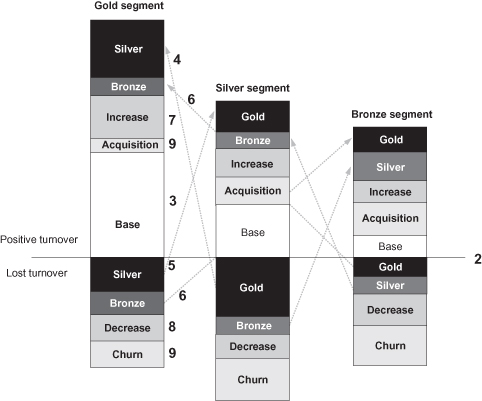USING CUSTOMER ANALYTICS AS INSPIRATION FOR A CRM STRATEGY
In the section “From Strategy to Menu,” we presented a top-down (strategic) approach to how you can establish a CRM strategy. Market conditions, given objectives, or your role in the organization determines which CRM activities you should pursue. In the section “Generic CRM Strategy” we presented a generic and commonsense approach to how you can prioritize your CRM activities. Here we present a bottom-up (data-driven) approach that is based on trends and movements in the value segments of your customer base and can give indications of what CRM activities you should focus on.
This approach is a natural extrapolation of the generic CRM approach presented earlier, which explained all the basic terms used in Exhibit 2.9 and the logic behind them. The basic idea behind this approach is to track, on a value segment basis, how the profit or turnover is generated between periods. This model therefore gives you an idea about how your customers have moved between value segments since the last period and how successful your acquisition, up-selling and cross-selling, and retention activities have been.
Exhibit 2.9 Parts of the Segment and Turnover Movement Model

You do not need to have an existing value-based segmentation model to do this analysis. As long as you can allocate the turnover to specific customers and define new and lost ...
Get Business Analytics for Sales and Marketing Managers: How to Compete in the Information Age now with the O’Reilly learning platform.
O’Reilly members experience books, live events, courses curated by job role, and more from O’Reilly and nearly 200 top publishers.

